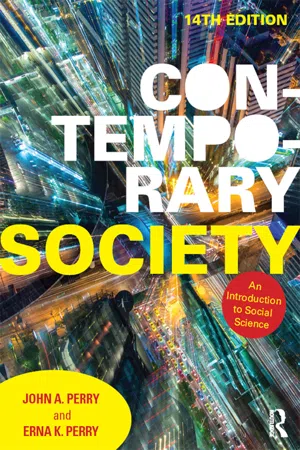![]()
© Rawpixel.com/Shutterstock
Through the Lens of Science
IN THIS CHAPTER, YOU WILL LEARN
• of the existence of the external world, which we inherit, and the social world, which we create;
• that the analysis of the social world with the tools of science is a fairly recent innovation;
• the basic differences between the social and the natural sciences;
• which disciplines constitute the social sciences;
• the elements and steps of the scientific method; and
• the various research methods used in the social sciences.
Life on our planet has undergone tremendous and dramatic changes since its beginning, both in the natural world into which we are born and the social world we have created and in which we live. What do we mean by the natural and the social worlds? Clearly, at birth all living things enter a physical world that is not of their own making. Plants and animals either adapt to this ready-made environment or die out. They cannot change the nature of their habitat, for on planet earth all living organisms exist in an environment shaped by forces and governed by laws that are only partially and imperfectly understood and only minimally amenable to change or control. Early humans did not understand this world, so they attributed many phenomena to spirits and supernatural beings. Today, the natural world is studied by the methods of science in such disciplines as biology, physics, chemistry, ecology, and so on. These disciplines are the so-called natural or exact sciences and are not within the realm of our inquiry in this text.
Each newly born human being, however, also enters a social world that has been shaped by those born previously and is continually reshaped by each new generation. The existence of this social world, although taken for granted by the majority of people, is of seminal importance to humans. It is what distinguishes them from other animals. Animals, aside from certain biological adaptations to new environments or climates (adaptations that sometimes lead to their extinction), retain an essentially unchanged lifestyle from the moment of their emergence. Humans, on the other hand, have manipulated their social world to the point of affecting their own lifestyles dramatically. This social world was not always well understood either, but in the past 200-plus years, disciplines have originated with the goal of examining it with the same scientific methodology that the exact sciences use. These disciplines are collectively called the social sciences.
The social sciences were born in a period of turmoil, when new ideas and beliefs were causing conflict and fragmentation in European societies. They represented an attempt to make sense of a reality that had become too difficult to grasp with the old tools. They offered the hope that the social world—the way people live—could also be examined in a dispassionate, objective way. It was hoped that such an examination would yield specific rules of behavior for people to follow to improve their individual and collective lives.
Perhaps the expectations for the social sciences were too high: despite efforts, few grand theories have been developed or secrets of social life uncovered. Nonetheless, the social sciences and their methodology remain effective—and probably unique—tools for rationally examining our social world. Is there a need to examine this social world in which we exist? Definitely. Because we are rational beings, we want to know which laws govern our lives, both in the natural and the social worlds we inhabit.
The Social Sciences
The purpose of the social sciences is to study systematically all aspects of the human condition and of human behavior, using a methodology borrowed from the physical sciences wherever possible. This insistence on systematic and methodical study is what distinguishes the social sciences from philosophy, art, and literature, disciplines which also comment and reflect on all facets of the human condition. Artists, poets, and philosophers express their insights into human behavior by availing themselves of such tools as intuition, imagination, authority, tradition, rational thought, and common sense. These tools are available to all of us and we use them every day.
Unfortunately, these tools have a major shortcoming: they are not always accurate and thorough, and they are often colored by individual or societal beliefs and prejudices. For centuries people believed that the earth was flat, and one could fall off its edge. That was a reasonable deduction if one used only one’s eyesight. It was also an accepted belief that the earth was the center of the universe and the sun went around it. When instruments were invented that could measure and see beyond the human senses, the knowledge that had been accepted as truth needed to be modified, and that did not happen without a fight. The Polish astronomer Nicolaus Copernicus (1473–1543) and the Italian astronomer Galileo Galilei (1564–1642) were ostracized and nearly lost their lives when they tried to convince their compatriots that it was the earth that circled the sun, not the other way around. The new knowledge challenged the ancient beliefs of authorities such as Aristotle and the Catholic Church. These two astronomers had not trusted their senses alone, but attempted to arrive at the truth by using a new tool of inquiry: science.
The Social World Seen Through the Lens of Science
Science may be briefly defined as a method using a system of rational inquiry dependent on the empirical testing of facts. It is this method, rather than a particular body of content, that gives scientists a unique way of looking at things. The purpose of the scientific method is to obtain evidence that is verifiable and subject to replication. Science makes no judgment about even the most seemingly obvious “facts” until original suppositions are overwhelmingly supported by proof.
IMAGE 1.1 Technology marches on! Social scientists have another tool at their disposal—the ubiquitous computer—to help them in researching how people interact even in the remotest societies.
© Tim Laman/National Geographic Creative/Corbis
IMAGE 1.2 Galileo Galilei, an Italian astronomer and mathematician, built one of the earliest telescopes, which he is showing in this drawing. Having looked at the night sky with this new tool, he theorized that it was the earth that moved around the sun and not the other way around, as was commonly believed in his time. Today, the social sciences also attempt to dispel some widely held, but incorrect, beliefs.
© DEA / G. DAGLI ORTI
The social sciences emerged when a number of philosophers determined to use the scientific method to study specific aspects of human behavior. Initially, the so-called social philosophy differed little from philosophy in general. Ideas prevalent in the eighteenth century, during the era commonly called the Enlightenment, led to the division of social philosophy into a number of separate disciplines. This historical period was characterized by an increase in people’s faith in the power of reason. Scholars and philosophers became convinced that just as universal laws of nature had been discovered by natural scientists through the use of the scientific method, similar laws would become apparent if human behavior could be examined by the same approach. Once the principles of social life were uncovered, they theorized, a more perfect society could be attained.
The need for a new approach to the analysis of human social behavior was prompted by dramatic societal changes. The conditions brought about by the Industrial Revolution and the movement of people to cities led to changed societies and many new problems. For one thing, the rise of industry resulted in the emergence of two new social classes: the owners of manufacturing machinery and the industrial workers who operated it. There were vast discrepancies in the standards of living between these two social classes. The workers labored for long hours in difficult conditions and suffered frequent layoffs. More people moved to cities in search of factory jobs, and cities became places in which overcrowding and lack of hygiene were rampant. Soon, poverty and crime followed.
This is why social scientists wanted to solve these problems, and they thought they could do so by applying the scientific method to human behavior. So arose the social sciences. These include cultural anthropology, economics, geography (including demography and ecology), political science, psychology, sociology, and those dimensions of history that go beyond the strictly narrative recounting of events.
What do the social sciences study today? Numerous economists produce studies that try to explain how economies work. What caused the meltdown of the American and world economies? What produces unemployment? Why do workers experience the loss of jobs in specific industries or segments of the economy? What is the effect of an increase in taxes on the economy? On individuals? Does everyone benefit when taxes are cut?
Sociologists inquire into the income level of students who attend a four-year university and those who attend a two-year school. Which students graduate from these schools, and which drop out? Why? Is it a matter of money or are other issues involved? (Stephan, Rosenbaum, & Person, 2010).
Sociologists and demographers study elderly immigrants. They note that they often live in conditions of isolation. Their young children assimilate and accommodate themselves to American society, but parents and grandparents cannot. They generally do not speak English, and many do not drive. They feel rejected and become depressed. Such research, when it is made public, activates social agencies into offering help (Brown, 2009).
Sociologists, psychologists, and economists often cooperate in designing studies. What produces the urge to buy a specific product? Which part of the brain is active when a person decides to spend money? (Tierney, 2007, D1). Which social interactions go on when people give themselves reasons for specific behavior and beliefs? (Gladwell, 2006, 80).
Criminologists, who use a number of social science disciplines—sociology, psychology, anthropology—study conditions leading to criminal behavior, recidivism rates, the effect of prison on inmates, and many other issues. Psychiatrists and psychologists have been helpful to victims of a variety of crimes, particularly rapes and kidnappings, aiding in their readjustment to society.
Archaeologists continually find fossils that tell us about changes in the natural world. They also discover remains of past societies that have left no written records, enabling us to see the important progression of culture.
IMAGE 1.3 Archaeological research includes much dirty work as researchers dig and sift through many layers to find the fossils that provide clues to the history of the human race.
iStock: © cafaphotos
Finally, the social sciences are increasingly combining with the exact sciences to discover findings in the areas of medicine and climate, findings that eventually affect and possibly benefit people and societies. The disciplines of social cognitive neuroscience study the way genes influence behavior—using biological information—and vice versa, how social behavior affects biology—in the form of genetic changes.
The Scientific Method
In defining the social sciences, the key to remember is that they study data systematically and methodically. In other words, they use the scientific method. This method uses both qualitative and quantitative approaches, the one describing, defining, and concerned with meanings, the other focusing on counting and measuring phenomena.
Subjecting the social world to scientific scrutiny involves the use of concepts, theories, and research. However, social science disciplines cannot employ exactly the same methodology as the natural or physical sciences do; but all disciplines share the scientific method. The basic technique of the scientific method is a special kind of observation called scientific observation. This kind of observation differs from simply looking around. Those of us who have the use of our vision look at things all the time, but we seldom arrive at scientific conclusions. We obtain evidence from our senses, but such evidence is not always reliable. Scientific observation must proceed systematically: scientists must select and define a problem and then make an organized plan for collecting data. Scientific observation must be accurate and precise; scientists must subject collected data to careful checking, rechecking, and cross-checking, as well as to careful measurement. Scientific observation should take place under controlled conditions; particular features of the environment should remain constant, so that when other features change, researchers can be sure which specific cause is determining which effect. This ...




